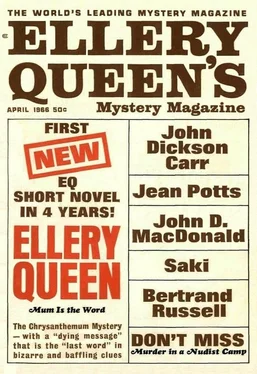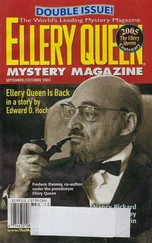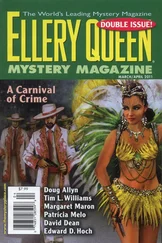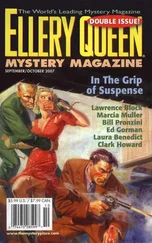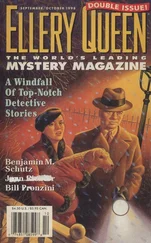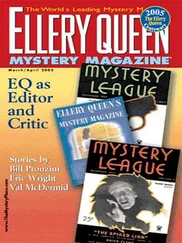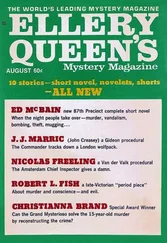Эллери Куин - Ellery Queen’s Mystery Magazine. Vol. 47, No. 4. Whole No. 269, April 1966
Здесь есть возможность читать онлайн «Эллери Куин - Ellery Queen’s Mystery Magazine. Vol. 47, No. 4. Whole No. 269, April 1966» весь текст электронной книги совершенно бесплатно (целиком полную версию без сокращений). В некоторых случаях можно слушать аудио, скачать через торрент в формате fb2 и присутствует краткое содержание. Город: New York, Год выпуска: 1966, Издательство: Davis Publications, Жанр: Детектив, на английском языке. Описание произведения, (предисловие) а так же отзывы посетителей доступны на портале библиотеки ЛибКат.
- Название:Ellery Queen’s Mystery Magazine. Vol. 47, No. 4. Whole No. 269, April 1966
- Автор:
- Издательство:Davis Publications
- Жанр:
- Год:1966
- Город:New York
- ISBN:нет данных
- Рейтинг книги:4 / 5. Голосов: 1
-
Избранное:Добавить в избранное
- Отзывы:
-
Ваша оценка:
- 80
- 1
- 2
- 3
- 4
- 5
Ellery Queen’s Mystery Magazine. Vol. 47, No. 4. Whole No. 269, April 1966: краткое содержание, описание и аннотация
Предлагаем к чтению аннотацию, описание, краткое содержание или предисловие (зависит от того, что написал сам автор книги «Ellery Queen’s Mystery Magazine. Vol. 47, No. 4. Whole No. 269, April 1966»). Если вы не нашли необходимую информацию о книге — напишите в комментариях, мы постараемся отыскать её.
Ellery Queen’s Mystery Magazine. Vol. 47, No. 4. Whole No. 269, April 1966 — читать онлайн бесплатно полную книгу (весь текст) целиком
Ниже представлен текст книги, разбитый по страницам. Система сохранения места последней прочитанной страницы, позволяет с удобством читать онлайн бесплатно книгу «Ellery Queen’s Mystery Magazine. Vol. 47, No. 4. Whole No. 269, April 1966», без необходимости каждый раз заново искать на чём Вы остановились. Поставьте закладку, и сможете в любой момент перейти на страницу, на которой закончили чтение.
Интервал:
Закладка:
“You talk all-fired pretty,” said Chief Newby with a grin. “There’s only one thing.”
“And that is?”
“If the killer didn’t swipe the pendant, where is it?”
“That,” Ellery nodded morosely, “is Bingo.”
“I don’t mean to high-hat my betters,” twanged Newby, “but you have to admit you’ve got a tendency to bypass the obvious. All right, you hit on M-U-M as Godfrey’s 13-21-13 safe combination. But why does that have to have anything to do with his reason for writing MUM on the pad? He was a bug on mums, so it was natural for him to use M-U-M as the combination. But he could have meant something entirely different when he wrote M-U-M on the pad. I still say he was fingering his murderer. And when you have a suspect around who’s actually known as M-U-M, and called Mum, what more do you want?”
“Mum Caswell isn’t the only obvious referent.”
“Come again?”
Ellery’s reasoning organ, needled by a phrase Newby had used, was busy with its embroidery.
“A bug on mums, you say. My point is, it’s absolutely bizarre and incredible that MUM should have been his dying message. MUM is the symbol of the man who wrote it. He was a famous horticulturist specializing in mums. Everything about the man said MUM, from the flowers in his greenhouse to the oil paintings and prints and sculptures and intaglios and jewelry and Lord knows what else of them throughout the place. MUM was Mumford’s trademark: a mum on his stationery, as I’ve taken the trouble to check; also on his wallet, and on his car, and in wrought iron over the front entrance. The moldings and doorknobs are all decorated with carved mums. And did you notice that his shirts sport an embroidered mum instead of his monogram? Also, if you’ll pardon me, there’s the irony of the knife that took his life, Godfrey’s boyhood knife. How many times, allow me to wonder, did little Goddie Mumford play mum blety-peg with it?”
At this terminal extravagance — this spacecraft leap into whimsy — the Chief could not avoid a groan. Ellery rose, undismayed.
“It’s that kind of case, Newby. And by the way, there’s one line of investigation I haven’t followed through yet. The search for that safe combination sidetracked me. I’ll look into it tomorrow morning.”
January 12
Having strained his prerogatives as a houseguest by arranging to borrow one of the Mumford cars, Ellery came downstairs the next morning before anyone else was up; and as he was passing the table in the foyer something caught his eye. There was a letter on the silver salver.
Being the world’s nosiest noonan, Mr. Q paused to look it over. The dime-store envelope was unstamped, unpostmarked, and addressed in a childishly disguised scrawl.
The envelope read: To Ellery.
He was surprised and delighted — surprised because the letter was so totally unexpected, delighted because he was in great need of a new point of inquiry. He tore open the envelope and removed from it a sheet of cheap notepaper.
The handwriting of the message was similarly disguised:
12/1/65
Mum’s the word. If you tell what you know I’ll kill you, too.
There was no signature.
Was this a new development? Hardly. All it did was obfuscate the mystification. The letter was from a not too uncommon type — the garrulous murderer; but what was he, Ellery, supposed to “know”? Whatever it was, he ardently wished he knew it.
He began to chew on the problem. After a while he began to look more cheerful. Obviously, his supposed knowledge was dangerous to the murderer. A yeast was therefore at work in the brew. Fear — the killer’s fear — might produce a heady potion on which the killer would choke.
Ellery slipped the letter into his pocket and left the house.
He drove the station wagon to Connhaven, where he made for the Merrimac campus. Here he sought out the university museum. In the main office of the tomblike building he found waiting for him — he had telephoned ahead for the appointment — Wolcott Thorp.
“You have me all atwitter, Mr. Queen.” The curator touched Ellery’s hand with his papery paw. “And not entirely at ease. I assume you’re working on poor Godfrey’s murder. Why me?”
“You’re a suspect,” Ellery pointed out.
“Of course!” And Thorp hastened to add, “Aren’t we all? If I’m acting guilty, it’s human nature.”
“That’s the trouble, or one of them.” Ellery smiled. “I’m familiar with the psychology of guilt by confrontation, even of the innocent. But that’s not what I’m here for, so stop worrying. A museum to me is what the circus is to small boys. Do you have time to show me around yours?”
“Oh, yes!” Thorp began to beam.
“I’m curious about your particular field. It’s West Africa, isn’t it?”
The beam became sheer sunshine. “My friend,” said Wolcott Thorp, “come with me! No, this way...”
For the next hour Ellery was the beneficiary of the man’s genuine erudition. Ellery’s interest was by no means simulated. He had a deep-rooted feeling for antiquity and anthropology (what was it but detection of a different kind?), and he was fascinated by the artifacts Thorp showed him from what had been western Sudan and the district of Kayes on the Senegal — idols and tutelary gods, fetishes, masks, charms, headdresses of pompons used by the Mandingos to ward off the powers of evil.
Happily inundated with information, Ellery finally interrupted the curator’s flow long enough to ask for a sheet of paper on which to make notes. The curator obliged with a piece of museum stationery; and Ellery, preparing to notate, forced himself back from the dark tribalisms of Africa.
The inscription on the museum letterhead was arranged in two lines. The top line was simply the initials of the museum; the line below spelled out the full name: Merrimac University Museum.
The top line... MUM.
Thorp had excused himself for a moment; and folding the paper, clean of unnoted notes, Ellery took from his pocket the anonymous letter he had picked up from the salver that morning. He was about to insert the museum letterhead into the envelope when his attention was caught by the envelope’s scrawled salutation.
To Ellery.
No, that was wrong!
To was correct enough, as he had read it, but not Ellery. The final letter had a long tail on it; this tail had been the cause of his mistaken reading. On re-examination the ry was not an ry at all; it was a straggle-tailed n.
To Ellen.
It was Ellen who knew something dangerous to the killer.
It was Ellen who was being threatened.
Wolcott Throp, returning, was astounded to see his visitor clap a hand to his head, jam a letter into his pocket, and dart out without so much as a fare-thee-well.
Crouched over the wheel of the station wagon, Ellery roared back to Wrightsville and the Mumford house, cursing every impediment that forced him to slacken speed. He left the car in the driveway and clattered past an alarmed Margaret Caswell and up the stairs in the longest leaps his long legs could manage.
He burst into Ellen’s room.
Ellen, propped up on a chaise longue by a picture window in some flowing garment that might have been designed for a painting by Gainsborough, was sipping hot chocolate from what could only have been — even in his agitation Ellery noticed it — a bone-china mustache cup.
“Am I supposed to be flattered, Mr. Queen,” asked Ellen in a her-Ladyship-is-not-amused sort of voice, “by your boorish intrusion?”
“Beg pardon,” panted Ellery. “I thought you might be dead.”
Her Wedgwood eyes blued further. She set the antique cup down on an end table. “Did you say dead?”
Читать дальшеИнтервал:
Закладка:
Похожие книги на «Ellery Queen’s Mystery Magazine. Vol. 47, No. 4. Whole No. 269, April 1966»
Представляем Вашему вниманию похожие книги на «Ellery Queen’s Mystery Magazine. Vol. 47, No. 4. Whole No. 269, April 1966» списком для выбора. Мы отобрали схожую по названию и смыслу литературу в надежде предоставить читателям больше вариантов отыскать новые, интересные, ещё непрочитанные произведения.
Обсуждение, отзывы о книге «Ellery Queen’s Mystery Magazine. Vol. 47, No. 4. Whole No. 269, April 1966» и просто собственные мнения читателей. Оставьте ваши комментарии, напишите, что Вы думаете о произведении, его смысле или главных героях. Укажите что конкретно понравилось, а что нет, и почему Вы так считаете.
